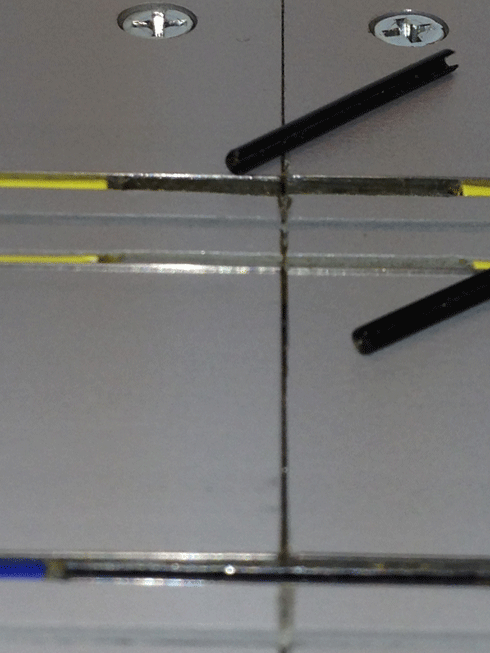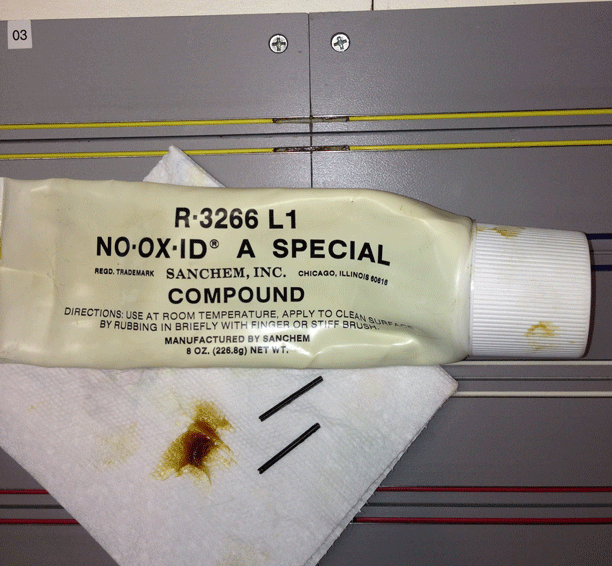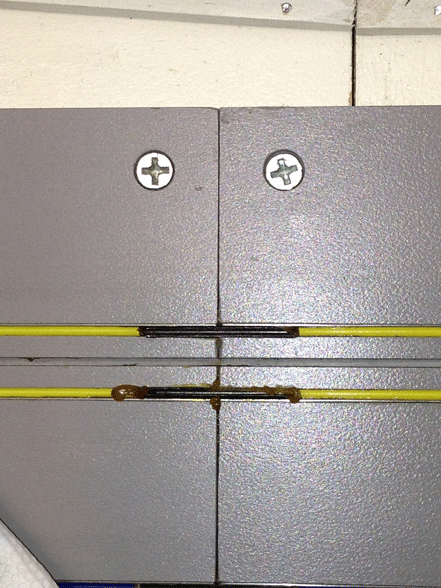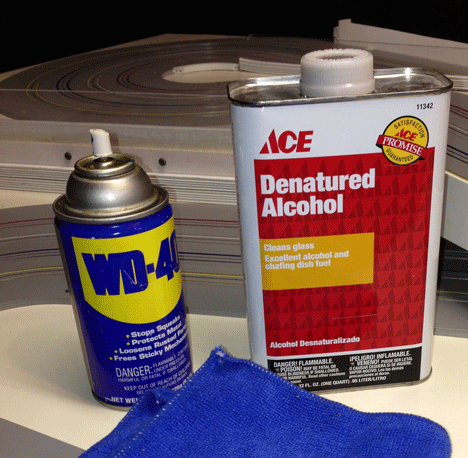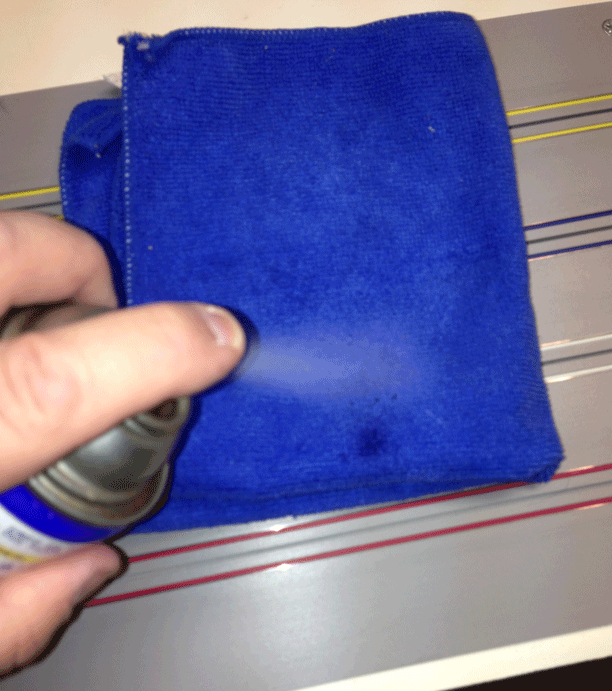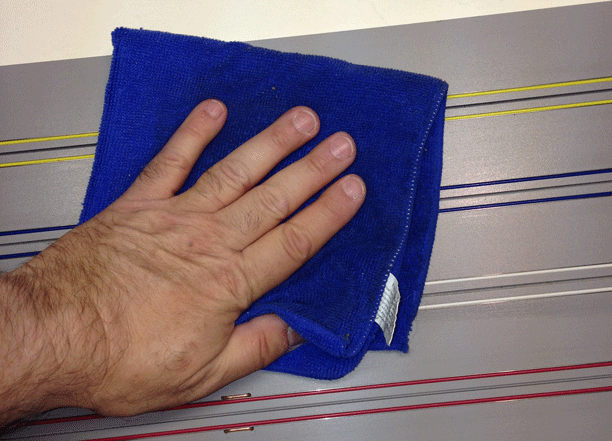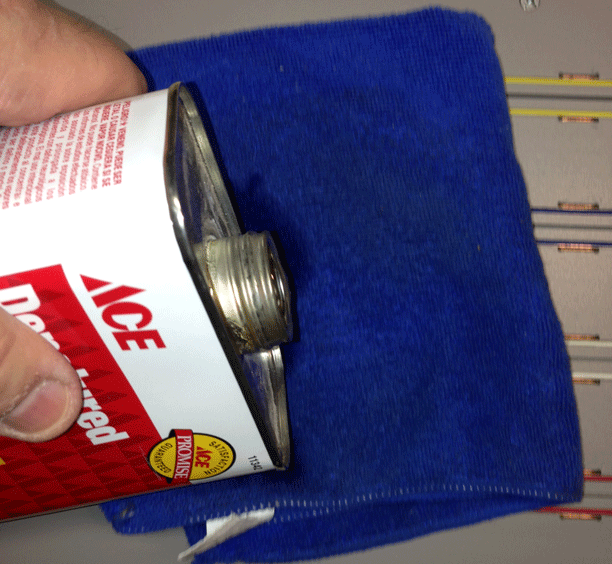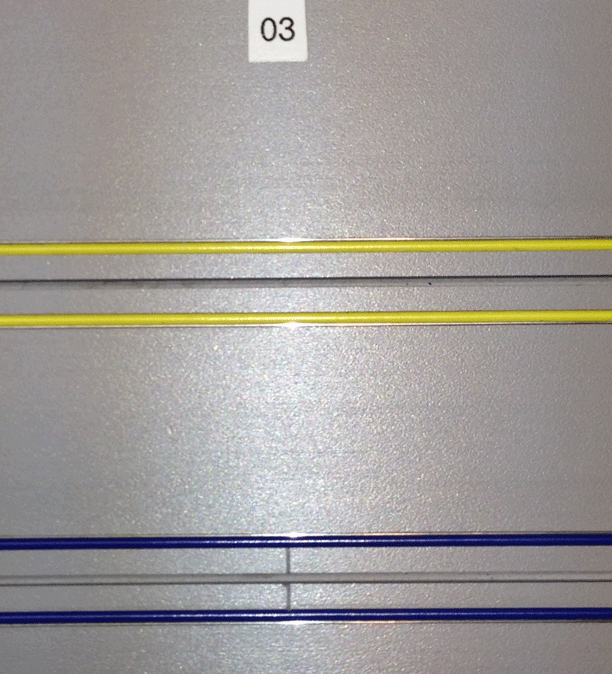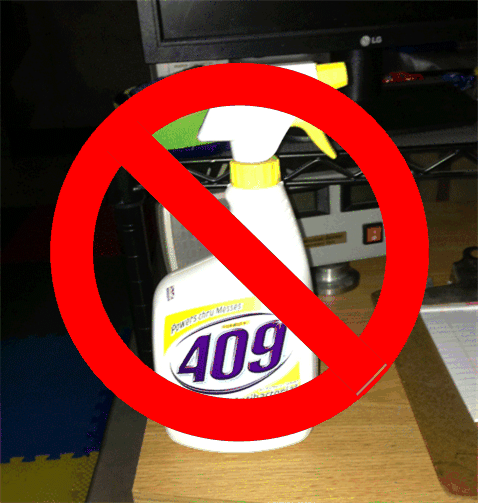The rails on most slot car tracks are carbon steel. Most Maxtrax tracks use a magnetic stainless steel rail. Stainless steel has some advantages as the rails are more resistant to oxidizing (e.g. rust) than conventional carbon steel rail track. However magnetic stainless steel contains iron and will rust. Previous versions of this page recommended the use of water based cleaners. That cleaning method resulted in corrosion of the rails in non-visible surfaces such as the rail key slots. While the use of stainless steel cleaner may be helpful for tracks with stainless steel rails the use of these materials is also not recommended. The following method was adopted after it was discovered that the use of water based cleaners caused corrosion to the Maxtrax rails in the key slot connections between track sections. As the keys transfer electricity between track sections track performance suffered. The following cleaning method was used following repairs to the Maxtrax and works without issue. Stainless steel cleaners and rail treatments such as Rail-Zip are not required with this method. The new TKO track exclusively uses the following cleaning and corrosion prevention methods.
Cause of the Problem
Maxtrax recommends the use of Formula 409 Glass and Surface Cleaner. While this water based cleaner did remove dust and oil from the surface it didn't do anything for the rails and burnishing of the rails and rail treatments such as Rail-Zip were required. The track also required cleaning before each practice session unless the track had literally been used the night before. The use of water based cleaners eventually caused severe corrosion to the track joints. While the track felt OK I decided to measure the resistance of the joints between track sections. The resistance of a joint should be well under one ohm. Resistances approaching one mega-ohm (1,000,000 Ohms) were measured. Removal of the keys and visual inspection revealed rust and corrosion on both rail and key.
Remediation And Corrosion Prevention
The track was removed from the table to remove rust or corrosion in the key slots. The keys cleaned up well with a soaking in rust removing gun cleaning oil, light sanding and wire brushing. Removal of rust and corrosion in the rail slots was another thing altogether. Dental tools, sandpaper, emery boards and rust removing gun cleaning oils were used. During the corrosion removal process I did some research and identified a corrosion preventative to be used when the track was reassembled. The corrosion preventative is NO-OX-ID "A-SPECIAL" conductive grease and is available from Sanchem Inc of Chicago IL. NO-OX-ID "A-SPECIAL" is an electrically conductive grease that is designed to keeps metals free from rust and corrosion. This electrically conductive grease which has been used in the power and marine industries for over 65 years to prevent corrosion in electrical connectors from low micro-power electronics to high voltage switchgear. NO-OX-ID electrical grease is designed to prevent the formation of oxides, sulfides and other corrosion deposits on copper, aluminum, and steel surfaces and conductors. Being a consultant for the electrical power industry I researched plant maintenance procedures and was pleased to find that this material is specifically recommended for use in maintenance of electrical switchgear. I obtained my supply of NO-OX-ID "A-SPECIAL" grease from E-Bay. Like most "conductive" greases it does not conduct electricity but it does prevent corrosion. NO-OX-ID "A-SPECIAL" is easy to work with. Using a double boiler method I melted a small amount of the grease in a plastic dish into which the keys were inserted. The melted grease coated the keys. Using a small stiff paint brush the NO-OX-ID "A-SPECIAL" was also applied to the rail in each key slot before the keys were inserted. The Maxtrax was sold several years later and its new owners were given a supply of NO-OX-ID "A-SPECIAL" grease. A visual inspection of the keys and joints when the track was disassembled revealed no new corrosion. I used NO-OX-ID "A-SPECIAL" when assembling the new TKO track. As with the Maxtrax both the rails in the key pockets and jumper pockets and the keys or jumpers were coated with grease before the jumpers or keys were inserted. After three years there is no visible corrosion and the ohmmeter readings are as good as when the track was built. The following photos show the process of applying the grease and inserting the keys in the splice between TKO track sections.
Key Pocket and Key
NO-OX-ID "A-SPECIAL" Conductive Grease
Key Installed
Note the excess grease being expelled from the key pocket. The excess grease should be removed with a paper towel and the track cleaned to remove any excess grease on the surface of the track. The keys and old grease was first removed for the above photos. As indicated previously the TKO is almost three years old. There was no visible corrosion when the keys were removed and the ohmmeter readings between track sections and at the jumper installations (which use a compression fit between the #14 AWG jumper wire and the rail) are as good as when the track was built. After assembling the track apply some of the remaining NO-OX-ID "A-SPECIAL" grease to your car battery terminals. They will thank you for it.
Track Cleaning
Having learned the hard way, I adopted a water free method for cleaning the track. This method was recommended by MSRA racers Bob Muys and Bill Deuser. It's quick, easy and works perfectly. With the water based method the track had to be cleaned weekly if the track was not used daily. I now can go months between track cleanings. With the water based methods the rails had to be sanded periodically to remove buildup. Now a microfiber towel is the most abrasive thing the track sees in between races. The cleaning method uses WD-40, a microfiber towel and denatured alcohol. Before a major race the cleaning process will first lightly burnish the rails with 1,000 grit paper applied to a padded wallboard sanding tool. The 1,000 grit sandpaper rig gets one lap with light hand pressure only. This lap is followed by the normal cleaning process. The normal cleaning process is as follows:
Step 1; Apply WD-40 to a clean folded microfiber towel. I typically fold the towel into fourths. Do not apply the WD-40 to the track directly. Step 2; Wipe the track with the wetted towel. Clean a four foot section wiping with the rails. You will see the track shine as the oil is applied. Continue cleaning the track in four foot sections using a clean portion of the towel when it gets dirty. I typically refold the towel at least three and more likely four times when cleaning my 57 foot track. Step 3; Allow the WD-40 to sit for 10-15 minutes. If the track is not going to be run for a while the track can be left in this condition. The WD-40 will not attack the plastic. Step 4; When the track is to be run remove the excess WD-40 by wetting a second folded microfiber towel with denatured alcohol. Like the WD-40 the denatured alcohol should not be applied directly to the track. Wipe the track with the wetted towel. Clean a four foot section wiping with the rails. You will see the track shine as the alcohol is applied. The alcohol will evaporate almost immediately leaving a clean dry track. Continue cleaning the track in four foot sections using a clean portion of the towel should it get dirty. The following photos illustrate the normal cleaning process:
Track Cleaning Materials
Microfiber towel, WD-40 and Denatured Alcohol.
WD-40 Applied to Towel
Normally I would be holding the towel so as to not spray WD-40 directly onto the track.
Cleaning the Track With WD-40
Note the oil sheen to the right of the towel as the WD-40 is being applied. Clean the track by wiping the towel with the rails. Clean the track in four to six foot sections.
Denatured Alcohol Applied to Towel
As with the WD-40 normally I would be holding the towel to not apply denatured alcohol directly onto the track. Remove the WD-40 by wiping the towel with the rails. Work the track in four to six foot sections. The alcohol will leave a sheen when applied and will evaporate within a few seconds.
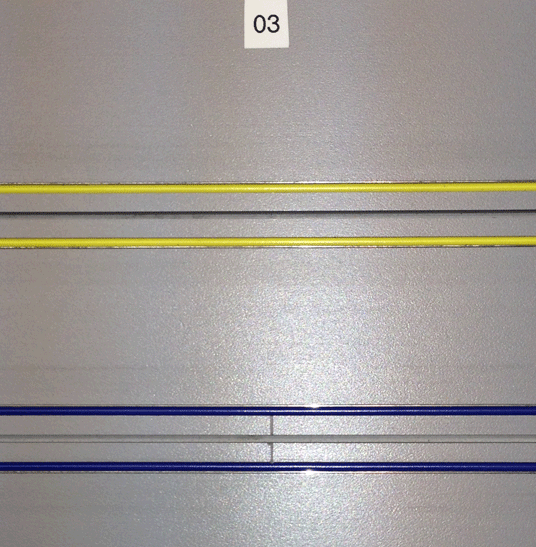
Before and After Cleaning
The cleaning process removed the buildup on the rails without abrasive cleaning. This cleaning did not first burnish the rails with the 1,000 grit sandpaper. The rails are burnished with 1,000 grit paper maybe twice a year if necessary. The remaining cleanings use only WD-40 and denatured alcohol. The WD-40 and alcohol are flammable materials and should not be used around hot objects, ignition sources and open flames.
Please Avoid Water Based Cleaners
